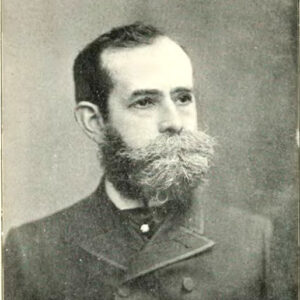calsfoundation@cals.org
Fort Bussey
Fort Bussey was an earthen fortification built astride the Military Road in Benton (Saline County) to protect Union forces occupying the town in late 1863 and early 1864. It was located at the intersection of the Military or Stagecoach Road and roads leading to Hot Springs (Garland County) and Pine Bluff (Jefferson County). The fort is no longer in existence, although remnants of it were still visible in the mid-twentieth century.
With the fall of Little Rock (Pulaski County) to Union forces on September 10, 1863, Confederates retreated through Benton on the way to Arkadelphia (Clark County). Within a few days, Union cavalry entered Benton as they scouted southward. On September 22, 1863, the community was occupied by 500 cavalrymen of the First Indiana Cavalry commanded by Colonel Thomas N. Pace. Three days later, Colonel John F. Ritter, commanding a brigade of Brigadier General John Davidson’s Cavalry Division, arrived with 1,500 men and artillery. Due to its proximity to Little Rock, only twenty-five miles away, Benton became an active outpost of the Union Army. From here, Union forces conducted numerous scouts and raids to Hot Springs, Mount Ida (Montgomery County), Rockport (Hot Spring County), Arkadelphia, Tulip (Dallas County), and Princeton (Dallas County).
By October 31, 1863, the primary occupying force of Benton was the Third Iowa Cavalry commanded by Lieutenant Colonel Henry Caldwell. In his report to his superiors in Little Rock, Caldwell stated that Benton was a very difficult place to defend successfully, and he recommended one or two redans at proper points and a small square redoubt on a high point in the rear of town. Caldwell felt these would suffice to defend against attack and enable the Federals to repel any Confederate assaults. On November 9, Major General Frederick Steele ordered an infantry regiment and an engineer officer to Benton to construct the necessary fortifications. By December, two enclosed works were completed covering the approaches to the town. The site was named Fort Bussey in honor of the Third Iowa Cavalry’s commander, Colonel Cyrus Bussey, who commanded a cavalry brigade in Davidson’s Cavalry Division.
The town remained occupied through the first four months of 1864 primarily by the Third Iowa Cavalry, Thirty-Second Iowa Infantry, and 106th Illinois Infantry. Officers occupied the nearby and adjacent Shoppach family home (Shoppach House), while the units rotated through garrisoning the fortifications. Inhabitants of the surrounding area for miles around had their farms visited, where all vestiges of food, fodder, corn, and livestock were confiscated by the Union occupation forces. April 1864 witnessed the largest depredations as Steele’s army headed south during the Camden Expedition. The Federal soldiers seized food and materials as they passed through the area, causing hardship for local inhabitants. During the Southern Claims Commission hearings after the war, numerous Saline County residents applied for reimbursement, with most being denied.
In late 1864 and 1865, after fighting at Poison Spring, Marks’ Mills, and Jenkins’ Ferry, Union forces were content to remain in Little Rock and send occasional scouts to Benton. At times, Confederate forces occupied Benton, utilizing Fort Bussey themselves. However, no skirmishes or battles are associated with Fort Bussey, and it was destroyed during the building of two water towers and some homes in the 1900s.
For additional information:
Benton Courier, Centennial Number, Benton Courier, 1937, p. 14.
The War of the Rebellion: A Compilation of the Official Records of the Union and Confederate Armies. Series 1, Vol. 22, part 1, pp. 728–729, 752, 767; part 2, pp. 700, 724, 1025, 1027, 1043, 1090–1091. Washington DC: Government Printing Office, 1888.
Anthony Rushing
Benton, Arkansas
 Civil War through Reconstruction, 1861 through 1874
Civil War through Reconstruction, 1861 through 1874 Military
Military Cyrus Bussey
Cyrus Bussey 




Comments
No comments on this entry yet.